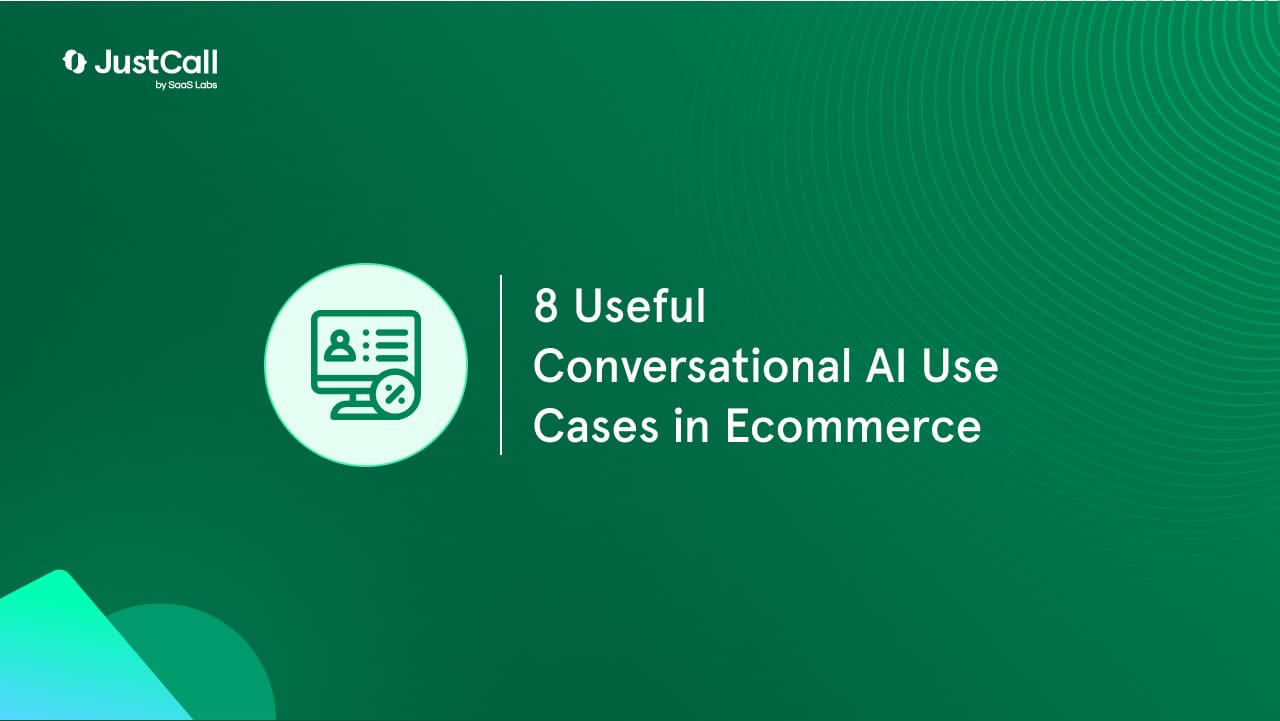When customers shop on your website, they leave behind a trail of important data points that your brand can—and should—leverage to improve their user experience.
But over time, thousands of customers shopping for billions of products can lead to data lakes that cannot be manually captured or analyzed. This is where the application of AI in ecommerce can turn out to be a game-changer.
In this guide, we will look at 8 conversational commerce use cases that can give ecommerce businesses an edge in an intensely competitive landscape. Let’s get going.
Use of AI in Ecommerce: An Overview
Artificial intelligence is everywhere. Tools like Chat-GPT and GPT 4V have made AI the tool of the common man. As per BCG, around 80% of leaders use generative AI regularly. Further data reveals that for 70% of ecommerce decision-makers in North America and Europe, AI can boost personalization, and 54% hope AI can help with site search:
Clearly, ecommerce businesses looking to stand out from the crowd can benefit from this emerging technology too.
The biggest contribution of AI in ecommerce lies in how this technology uses data to transform core ecommerce processes—from product discovery to personalized shopping. Luckily, AI use cases in ecommerce find 360-degree applications (more on this in the next section).
Use Powerful Conversation Insights to Drive Call Center Success
How to Use AI in Ecommerce? 8 Interesting Examples
Using AI in ecommerce is not unheard of at this stage. Established giants like Amazon, Walmart, Sephora, etc., have been actively integrating technology with shopping to give customers an exceptional experience.
Today, the global AI adoption rate stands at 35%, and another 44% of organizations are currently working to embed AI into their current applications and processes. If ecommerce businesses wish to stay ahead of the curve, they will need to integrate AI into the current operational workflows.
Here are 8 examples of AI in ecommerce that businesses can get inspired from:
1. It can make search easier and more relevant
One ecommerce brand that has always been ahead of the curve when it comes to adopting technology is Nike.
The brand’s Visual Search functionality within the Nike App allows users to search for shoes by taking a picture or using a photo from their Gallery:
What makes this tool useful is it allows users to find products that they literally cannot describe in the right words. Using photos, users can find other similar-styled products and choose the right product without compromising on the quality or product type.
2. It can offer autosuggest features and save the customer’s time
Search is often the first point of contact for new or returning customers for any ecommerce website.
Now, imagine if a customer wants to buy a hyaluronic face serum. They get onto the site and search for the product. Instead of getting suggestions, they need to type out the whole product name, which can lead to misspelled queries, errors, etc. This certainly doesn’t qualify as a friction-free search experience.
Take a cue from Walmart which offers great autosuggest search functionality:
Simply typing “Hya” is enough to get the right product names. This is how exacting, relevant, and accurate an ecommerce website’s search should be.
Pro tip: AI-backed ecommerce platforms can also pull up items that are most likely to convert and re-rank the search results accordingly.
3. It can hyper-personalize customer experiences
Thanks to brands like Amazon, most ecommerce websites today – from Shopify to WooCommerce – use AI to suggest relevant products based on the customer’s previous searches and buying history.
Take a look at Watson’s website, which offers product suggestions that are ‘inspired’ by the user’s browsing history:
The brand goes the extra mile to categorize products and roll out personalized recommendations in a variety of ways, such as “The 10 Most Purchased Products,” “The 10 Most Browsed Products,” etc.
The brand is able to offer these suggestions due to AI tools that work in the background and collate data from the website. The tool can analyze mountains worth of data and provide shopping trends, patterns, and so on.
4. It can help set predictive pricing models
While Amazon gets many things right when it comes to using AI for ecommerce use cases, its dynamic pricing strategy is worth understanding.
The brand leverages sophisticated algorithms to update product prices multiple times a day! The end goal: To offer the most competitive prices to customers, and it succeeds marvelously. For instance, it offers a “Deals inspired by your recent history” section to help customers find the best deals of the day:
Notice how the brand showcases the number of deals claimed for each offer, creating a sense of urgency in the customer. Amazon leverages diverse data touch points to build a robust dynamic pricing strategy such as:
- Global demand and stock volume
- SKU visit ratio
- Day and time of purchase
5. It can automate conversion-related sales processes
Another interesting example of AI automation in ecommerce that is widely used is abandoned cart emails like the one FairPrice sends out to customers who have added items to the cart but did not push the checkout button:
An automation tool can automatically trigger an abandoned cart email if the customer is active on a webpage but has not completed the purchase yet. Sometimes, a small nudge in the offer of a discount or free shipping can convince the customer to make the purchase.
6. It can help customers leverage the services of AI-powered personal assistants
Want customers to try your products without stepping into the store? Sephora’s Virtual Artist functionality is an excellent example of how to use AI and make the shopping experience ultra-convenient for the customer:
Customers can try hundreds of makeup products from within the app without ever leaving their homes! This is the kind of fast and seamless service customers expect today, which can only be possible using AI.
7. It can help with sales forecasting and inventory management
The right kind of sales forecasting and inventory management can truly drive sales home. Nothing annoys customers more than eyeing ‘out of stock’ products.
Ecommerce brands must capitalize on every customer who intends to buy products. They must sufficiently stock in-demand products depending on the changing customer needs.
Given the rate at which supply chain disruptions occur today, manually handling inventory is a pipe dream. This is where conversational AI can:
- Analyze customer interactions across various communication touch points such as chats, emails, social media, etc.
- Identify trends in customer patterns and predict sales forecasts more accurately
- Gather real-time data from various sources, such as customer inquiries, purchase history, and website interactions, to identify product demand fluctuations, popular items, and potential sales opportunities
- Drive informed decisions about inventory management and stocking the right products
- Provide real-time visibility into stock levels, reorder points, and product availability, enabling proactive inventory management and reducing the risk of stockouts or overstocking
8. It can enable customers to get their queries addressed in real-time
AI-powered chatbots of today are way too advanced. They are doubling up as personal shopping ‘advisors,’ actively engaging customers in meaningful conversations.
Nordstrom’s live chat services are an interesting case in point. The brand has rounded up a series of frequently asked questions that addresses some of the most common customer questions in an instant:
Customers can literally self-serve themselves and get answers without waiting on hold:
The live chat option can be deployed to address customers 24x7x365. Plus, these automated tools do not tire or take breaks, ensuring no lead falls through the cracks.
The takeaway: Every ecommerce brand is leveraging AI in its own capacity. In fact, no two businesses have adopted the exact same AI strategy. The big learning here is that every organization must first identify the gaps within their ecommerce model and use AI-powered technology to fill said gaps.
Using AI in Ecommerce: Best Practices to Consider
There’s no dearth of using AI in ecommerce examples but not many ecommerce businesses get it right at first go. Hurried implementation, lack of planning, and improper resources/time are the major contributors to a failed AI implementation.
To make things easier, here are a few best practices to keep in mind when leveraging AI in ecommerce:
Tip #1: Don’t Turn a Blind Eye to User Data Privacy & Security
When integrating AI into your existing ecommerce workflow, prioritize your customer’s data privacy and security at all costs. Plus, disclose why your system is using AI and how the data will be used as Netflix does:
Keeping customers in the know can go a long way in gaining customer trust.
Tip #2: Foster Transparency in AI Development
Your ecommerce brand will only be as ethical as the data you input into the AI system. If the data is skewed or biased, it can promote unfair practices for certain customer segments.
Tip #3: Train Your Staff to Boost AI Adoption the Right Way
Irrespective of AI making inroads into ecommerce, the system is still new. So, you’ll need to train your agents so that they can leverage the power of machine learning to its maximum potential.
Tip #4: Don’t Forget About Your Sellers
While many ecommerce organizations are doing a stellar job catering to their customer’s every need at whim, eBay takes its AI usage one step further by empowering sellers to list clearer images on site with its “Image Clean-Up” feature:
This functionality not only enables sellers to boost their sales but also benefits eBay itself as the platform’s images become crystal clear.
Pro tip: When embracing AI, ecommerce businesses must think about helpful use cases for the sellers as well to provide a complete selling and shopping experience.
Tip #5: Voice Commerce is the Next Big Thing
In addition to taking care of everyday tasks, you can now shop with Amazon Alexa:
Amazon Alexa can create your own shopping list so that users never forget about anything on their must-buy list. That’s not where the magic ends. Alexa can also:
- Offer recommendations based on real customer ratings
- Inform customers of great deals occurring on Amazon
- Help customers to add items to the cart and checkout using their voice itself
- Track orders for you and provide real-time updates
Bonus Material: Additional AI Strategies to Embrace for a Superior Shopping Experience
- Use AI algorithms to map out interconnected products and enhance the search experience for customers
- Let machine learning tools help you understand which products are overselling so that you can stock them accurately
- Integrate Learn-to-rank systems so that your customers see relevant and appealing products
- Make use of AI to price your product right and present the best price to your customers
Use of AI in Ecommerce Will be the Norm, Not the Exception
There are thousands of examples of artificial intelligence in ecommerce that are transforming the retail space. In fact, experts claim that the future of retail and ecommerce is filled with robots, Augmented Reality, AI, and so on.
If ecommerce businesses want to cater to these next-gen shoppers, they need to rethink their strategy and leverage more ecommerce AI use cases like the ones mentioned in the blog above.
You’ll be surprised to know that in China, a staggering 80% of purchases are driven by personalized recommendations. And this will soon emerge as the industry standard, irrespective of your business scale, size, or scope. Conversational AI is the future of ecommerce, and the future is here.












